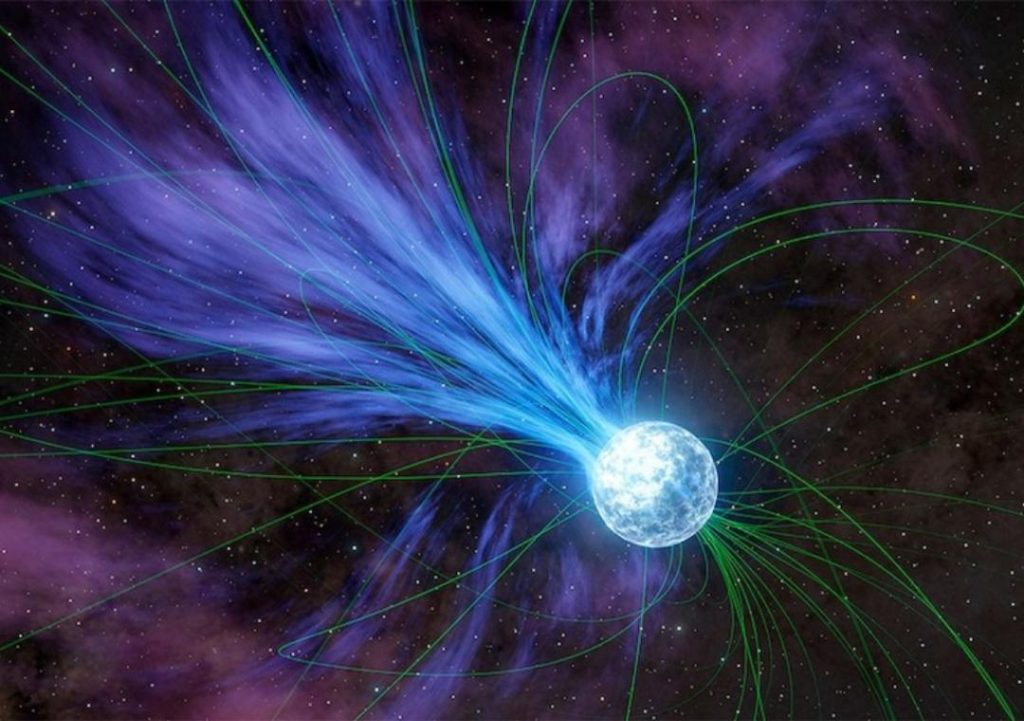
Gold & Platinum Created through Neutron Stars’ Explosions: Study
For centuries, humans have been fascinated by the origins of precious metals like gold and platinum. While we have long known that these metals are formed through geological processes on Earth, scientists have always wondered where they came from in the first place. A recent study led by Columbia University student Anirudh Patel has shed new light on this mystery, revealing that magnetars – highly magnetized neutron stars – played a crucial role in creating these elements.
According to the study, magnetars exploded and released flares that contained gold and platinum, among other elements, in a cosmic event that occurred over 20 years ago. This phenomenon is not a rare occurrence, as explosions of this kind happen approximately once per decade in the Milky Way and annually across the observable universe.
To understand how this happened, it’s essential to first grasp the concept of magnetars. These are incredibly powerful objects that are born when massive stars collapse under their own gravity. As the star collapses, its core becomes incredibly hot and dense, leading to the formation of a neutron star. This neutron star is then surrounded by a strong magnetic field, which is what gives magnetars their unique properties.
When a magnetar explodes, it releases an enormous amount of energy in the form of electromagnetic radiation. This radiation can travel vast distances across space, carrying with it the elements that were forged within the magnetar’s core. In the case of gold and platinum, these elements were likely created through a process known as rapid neutron capture, or r-process nucleosynthesis.
This process occurs when neutrons collide with atomic nuclei, causing them to absorb the neutrons and become heavier elements. In the case of gold and platinum, this process involves the absorption of large numbers of neutrons, which leads to the formation of these precious metals.
The study, which was published in the journal Science, used data from NASA’s Fermi Gamma-Ray Space Telescope to identify the explosion of a magnetar that occurred in 2004. By analyzing the light emitted by this explosion, scientists were able to determine the chemical composition of the flares that were released.
The results of the study were striking, with scientists detecting the presence of gold and platinum in the flares. This was a major breakthrough, as it provided the first direct evidence of the role that magnetars play in the creation of these precious metals.
But how did scientists arrive at this conclusion? To answer this question, we need to take a step back and examine the process of r-process nucleosynthesis.
R-process nucleosynthesis is a complex process that involves the interaction of neutrons with atomic nuclei. In the case of gold and platinum, this process involves the absorption of large numbers of neutrons, which leads to the formation of these heavy elements.
The process begins when a massive star collapses under its own gravity, leading to the formation of a neutron star. This neutron star is then surrounded by a strong magnetic field, which causes the neutron star to spin rapidly. As the neutron star spins, it creates a strong electromagnetic field that interacts with the surrounding matter.
This interaction causes the atoms in the surrounding matter to absorb neutrons, leading to the formation of heavier elements. In the case of gold and platinum, this process involves the absorption of large numbers of neutrons, which leads to the formation of these precious metals.
The study that led to this conclusion was conducted by a team of scientists led by Anirudh Patel, a student at Columbia University. The team used data from NASA’s Fermi Gamma-Ray Space Telescope to identify the explosion of a magnetar that occurred in 2004. By analyzing the light emitted by this explosion, scientists were able to determine the chemical composition of the flares that were released.
The results of the study were striking, with scientists detecting the presence of gold and platinum in the flares. This was a major breakthrough, as it provided the first direct evidence of the role that magnetars play in the creation of these precious metals.
So what does this mean for our understanding of the origins of gold and platinum? In short, it means that these precious metals were likely formed through the explosions of magnetars, rather than through geological processes on Earth.
This is a major breakthrough, as it provides a new perspective on the origins of these precious metals. It also highlights the incredible power of magnetars, which are capable of creating elements that are essential to our everyday lives.
In conclusion, the study led by Anirudh Patel has shed new light on the origins of gold and platinum. By analyzing the data from NASA’s Fermi Gamma-Ray Space Telescope, scientists were able to determine that magnetars played a crucial role in the creation of these precious metals.
This is a major breakthrough, as it provides a new perspective on the origins of these precious metals. It also highlights the incredible power of magnetars, which are capable of creating elements that are essential to our everyday lives.






